Wolves cemented their grip on seventh place in the Premier League with a resounding 3-1 win over Everton at Goodison Park. Goals from Ruben Neves, Raul Jimenez and Leander Dendoncker gave the Black Country side their first win away in the blue half of Merseyside since 1979. Andre Gomes restored parity for Marco Silva’s side midway through the first half, but it was Nuno Espirito Santo’s side who deservedly got the three goals and the all-important three points.
In this tactical analysis, we will focus on Wolves’ third goal – seeing as Neves’ goal was a penalty and Jimenez’s came from another Joao Moutinho set piece – Everton’s equaliser and a beautiful Belgian who continues to impress.
Team news
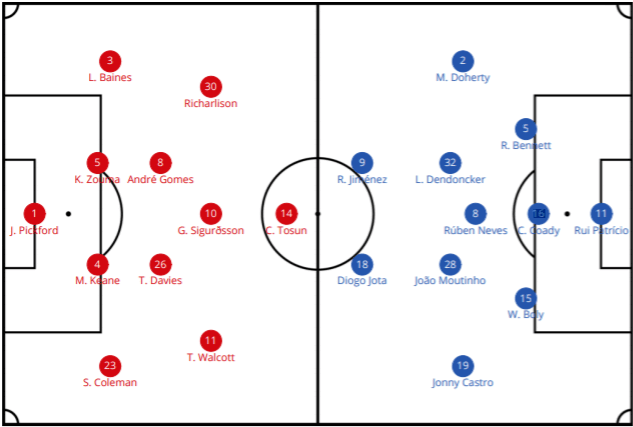
There were no shocks on either side. Perhaps the most surprising news was that Leighton Baines was passed fit and started for Everton. Rather unsurprisingly, he was substituted with the game still in the first half as Matt Doherty was getting the better of him with relative ease. This culminated in Wolves being awarded a penalty inside the first 10 minutes of the game and Neves beating Jordan Pickford from 12 yards.
Jonjoe Kenny was brought on for Baines and fared slightly better than the former Wigan man. However, it would ultimately be the wide areas which would cost Everton the game. Doherty’s penalty was won by bamboozling Baines on the Everton left and Wolves’ third came from Jonny Castro Otto’s hard work on the opposite flank.
While there were many differences between the two sides on the day, arguably one of the biggest was the balance, or in Everton’s case a lack of it. Bearing in mind Everton are set up in a 4-2-3-1 in the formation image above, let’s now take a look at their average positions on the day.
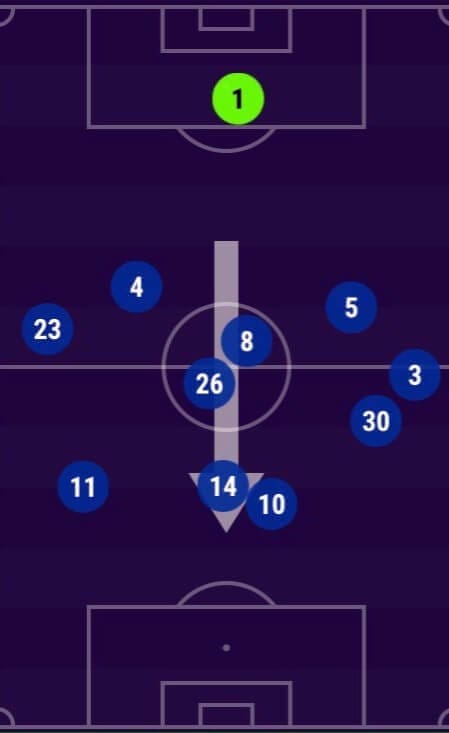
Whereas Richarlison (#30) and Baines (#3) worked in relative cohesion with one another, Seamus Coleman (#23) and Theo Walcott (#11) were almost on different planets to each other. Admittedly Gomes (#8) and Tom Davies (#26) acted as defensive pivots and were there to support the back line. All the same, Walcott was almost acting as his own individual entity rather than one of the team.
In addition, the space between Kurt Zouma (#5) and Michael Keane (#4) is far too wide and would end up costing Everton.
Discipline
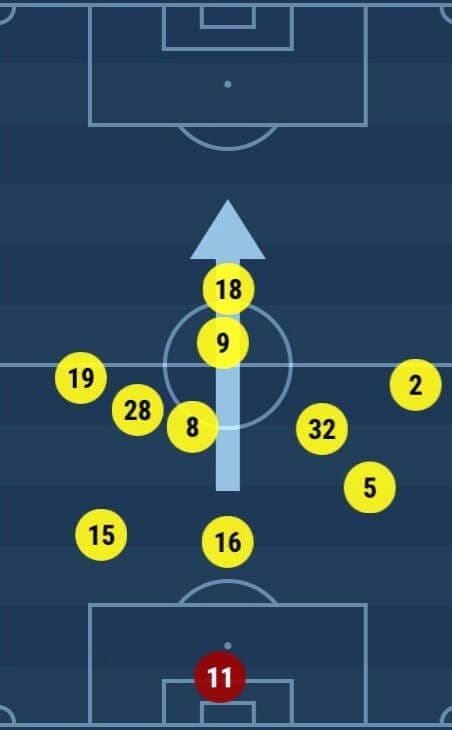
Essentially, Wolves’ 3-5-2 becomes 3-3-2-2 with the midfield trio of Neves (#8), Moutinho (#28) and Dendoncker (#32) sitting in front of the three centre-backs. Jonny (#19) and Doherty (#2) bring the width while Diogo Jota (#18) and Jimenez (#9) lead the pack.
In comparison to the average positions of the Everton side, Wolves are compact, almost as one. It’s this compactness and desire to hunt in a pack that has led Wolves to seventh in the table and might well see European football return to Molineux for the first time in decades.
Stats don’t tell the full story
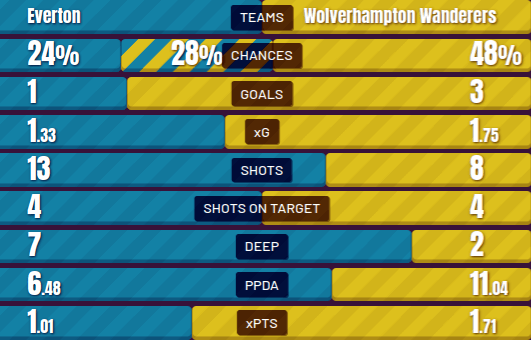
Looking at the infographic above, you’d think that Everton were hard done by having taken more shots on goal with the same number on target. For the record, Silva’s side also had significantly more possession that Wolves. Nevertheless, that’s when Wolves are at their most dangerous.
Focussing on the xG tally, the difference of 0.42 isn’t huge, but when you scratch beneath the surface, the image becomes clearer as demonstrated below.
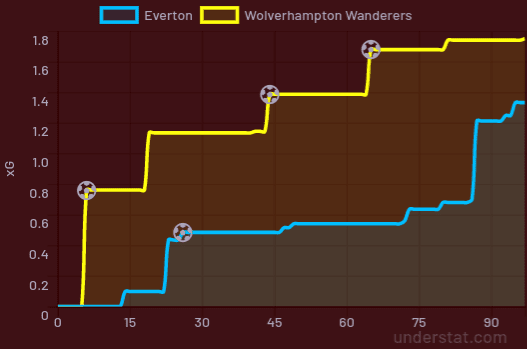
With 86 minutes on the clock, the xG scoreline read 0.70-1.74. It was only when Wolves decided to sit and absorb that Everton’s xG improved. It was an accomplished display from Nuno’s side as they continue to impress, but how did Everton find themselves back in the game after such a strong Wolves start (0.10-1.13 xG after 22 minutes)?
Great from Gomes
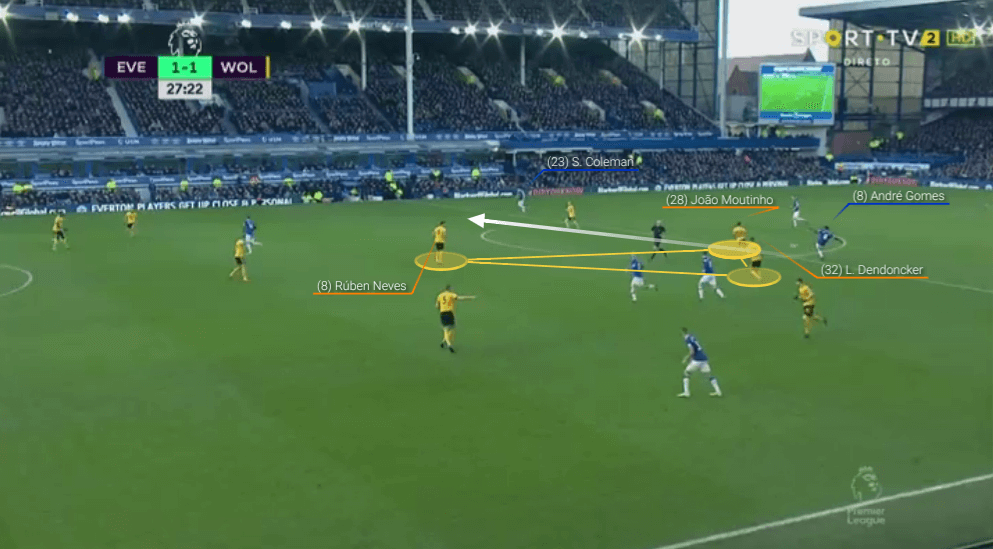
The Barcelona loanee, who was one of Everton’s best players throughout, spread the play to Seamus Coleman on the right before driving forward. None of the three highlighted Wolves players were able to stop Everton’s number eight picking the ball back up and rifling it beyond his fellow countryman, Rui Patricio.
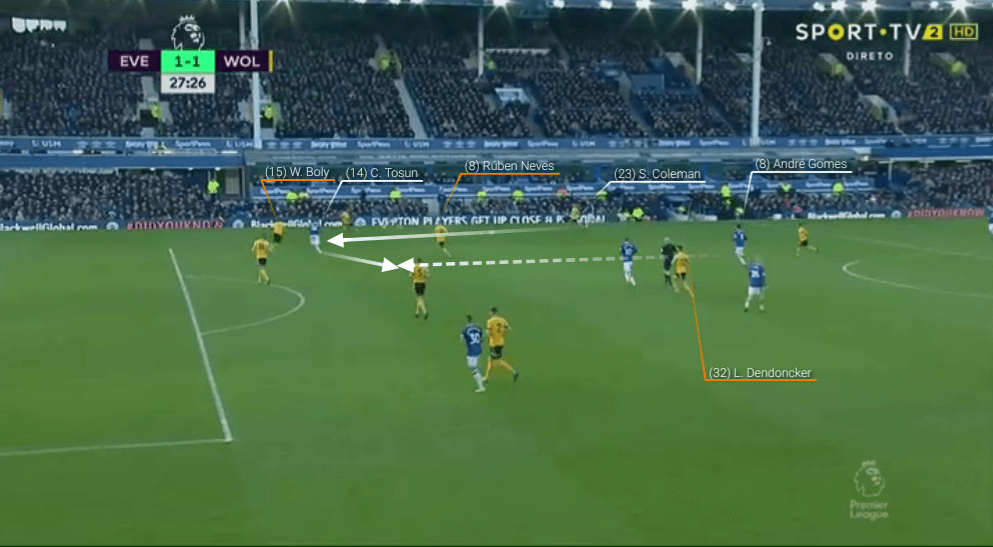
Cenk Tosun’s movement pulls Willy Boly out of the central defensive line which leaves room for Gomes to run into. Coleman plays the ball into Tosun, who lays it into Gomes’ path for the midfielder to make it 1-1. Have a look below.
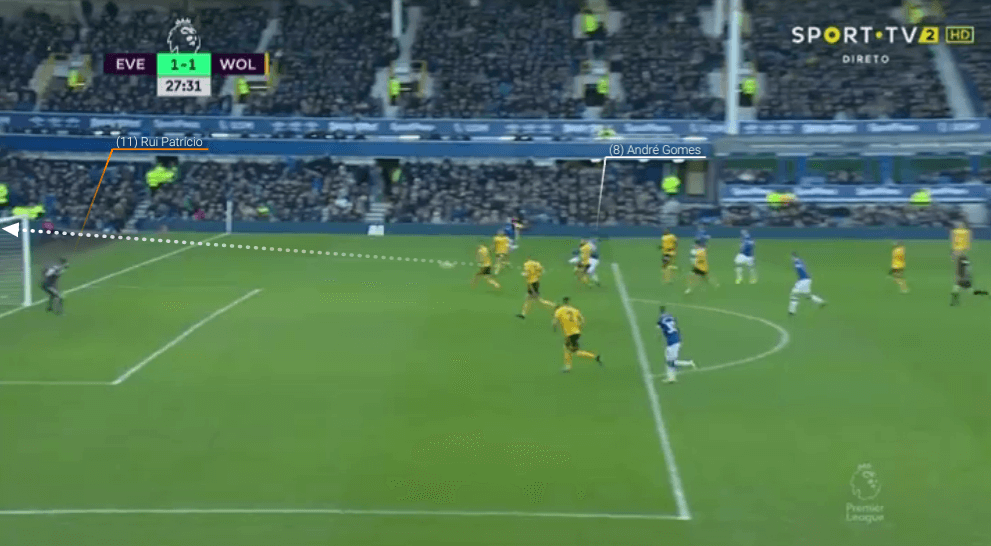
Gomes’ goal didn’t galvanise Everton as Silva would’ve probably hoped though. After Jimenez put the Molineux side back in the lead on the stroke of halftime, the result was never really in doubt.
Jimenez adds to his tally
Wolves fans’ would’ve had their hearts in their mouths when the Mexican forward went down injured early in the first half, but he dusted himself down to put in another blinding performance. The goal itself for Jimenez was a collection of awful marking from Everton and intelligent movement from the Wolves number nine.
If we look at his stats from the game, you begin to understand why he is making quite a name for himself in the old gold and black.
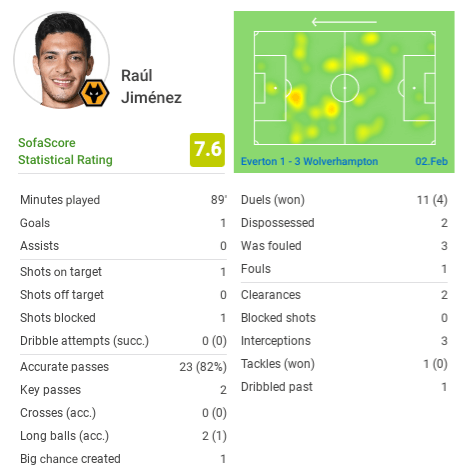
Two instances stand out from the game, asides from the goal. He teed up Dendoncker in the first half when he could’ve taken the shot on himself. It displayed a real element of unselfishness and even though Dendoncker’s effort was saved, it would’ve helped with the Belgian’s goal which came later in the game.
Secondly, the raking cross-field pass to Matt Doherty was nothing short of extraordinary. His belief in his own ability to even try that was there for all to see. Wolves fans everywhere will be hoping that long may it continue.
Dendoncker opens his account
After Dendoncker made his league debut against Spurs in late December, Wolves’ form has been on an upward trajectory and it’s no coincidence. Nuno’s switch from a 3-4-3 to 3-5-2 has also played a part. Nonetheless, Dendoncker is making himself undroppable and his goal on Saturday only amplifies that.
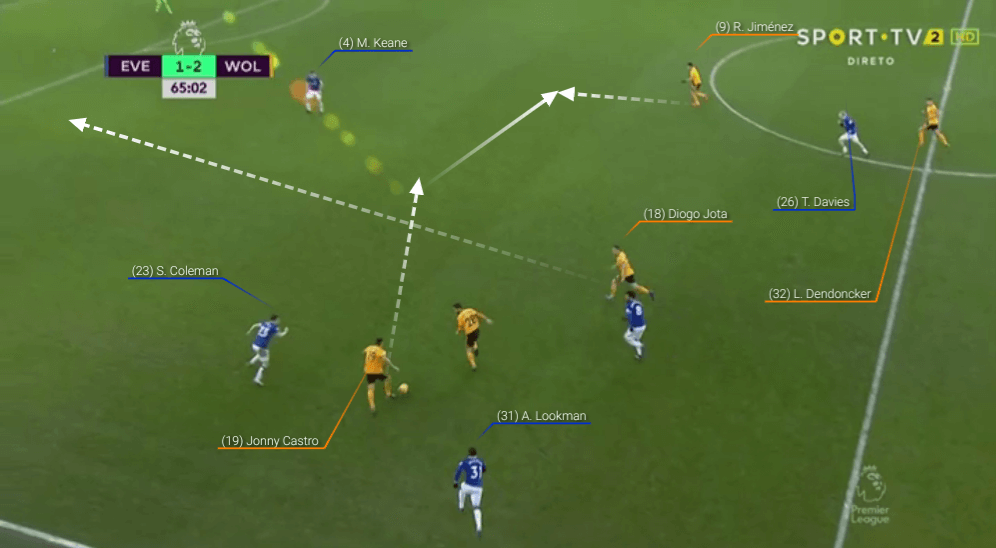
Jonny pinches the ball off Ademola Lookman and motors inside. Naturally, the player we need to centre our attention on is Dendoncker. He’s behind Tom Davies biding his time. Quite a bit happens between the above image and Dendoncker smashing the ball into the roof of the net.
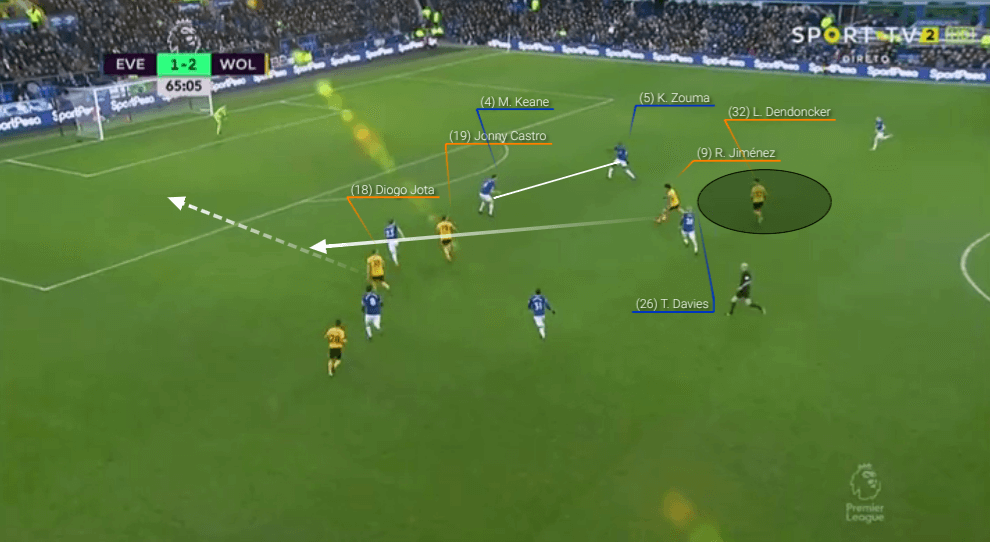
Jimenez plays the ball to Jota, who travels with the ball before having his shot blocked. That’s how it ends up with Dendoncker.

Davies is now miles away from Dendoncker as the Everton man decided to halt his run on the edge of the area, while the Wolves player pushes on and fires beyond England’s number one: game, set & match to Wolverhampton Wanderers.
Conclusion
Dendoncker’s all-round performance was cracking, Moutinho’s was imperious, Jimenez’s was impeccable. The other eight players who started could all come in for commendations as well as there wasn’t a single player in a Wolves top who deserved less than an eight out of 10. Everton, on the other hand, were below par all the over pitch.
In summary, Wolves were brilliant, Everton were dire and Nuno’s side got a deserved three points.
Until the next time.
If you love tactical analysis, then you’ll love the digital magazines from totalfootballanalysis.com – a guaranteed 100+ pages of pure tactical analysis covering topics from the Premier League, Serie A, La Liga, Bundesliga and many, many more. Buy your copy of the January issue for just ₤4.99 here, or even better sign up for a ₤50 annual membership (12 monthly issues plus the annual review) right here.

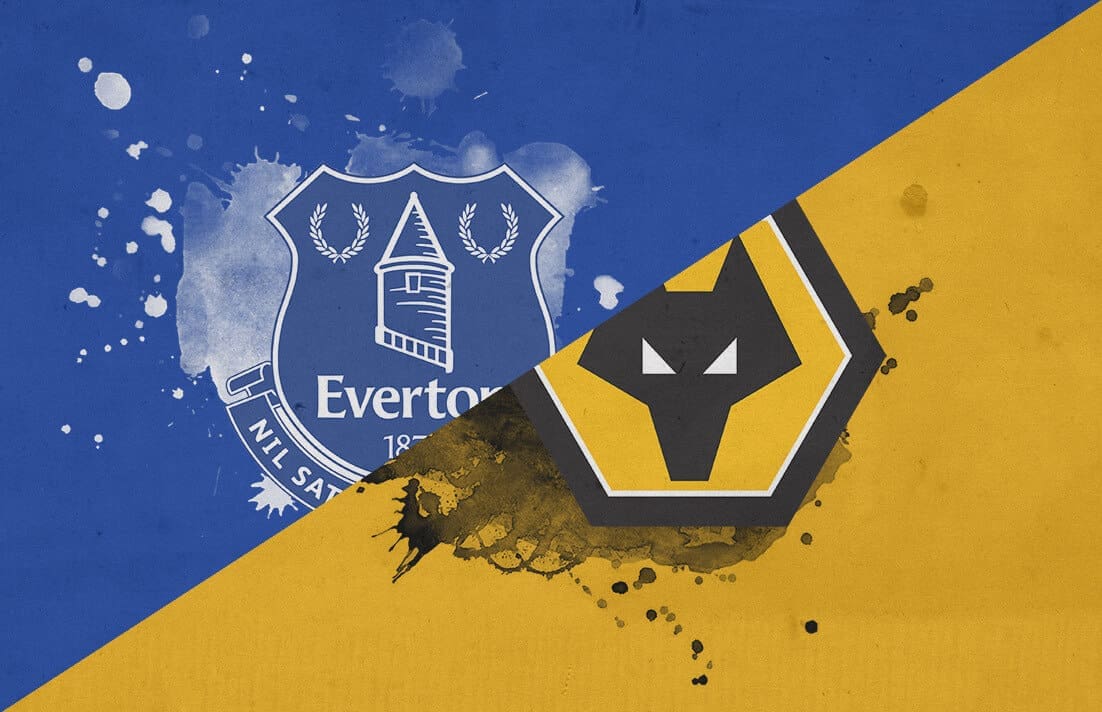



Comments